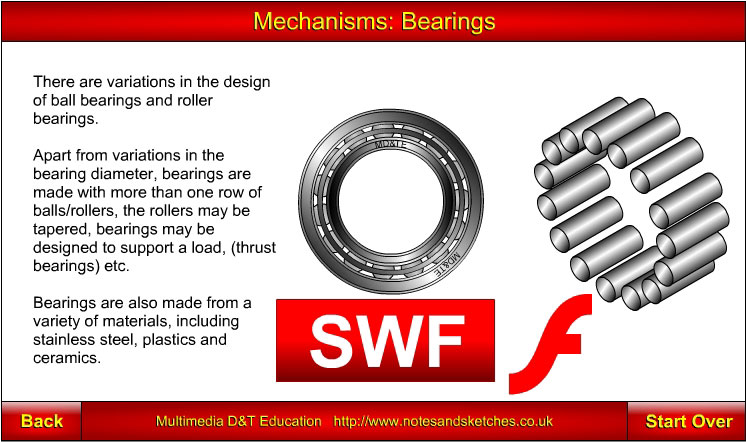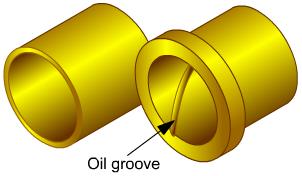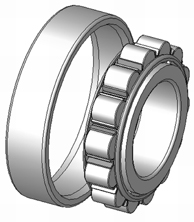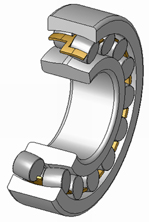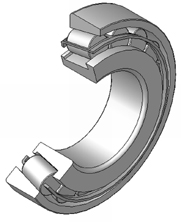An image showing the Flash animation logo  is a
link to a Flash animation. is a
link to a Flash animation.
Flash animations are embedded into the pages of all my D&T Modules but there are pictorial links to the animations on this web site so that devices that cannot play Flash animations will at least show a jpeg screenshot of the animation.
If your PC or personal digital assistant (PDA) can play Flash animations you may click on an image showing the Flash animation logo  to view the animation in a new window. to view the animation in a new window.
(Your browser may require you to click "Allow Blocked Content" to view the animation). See info about viewing Flash animations. |
Introduction
Mechanical systems have moving parts that transmit motion and force. The system may also convert one type of motion into another type of motion, e.g. rotary motion into reciprocating motion. In the ideal mechanical system all the input motion and force is converted into output motion and force. However, friction between various parts of the mechanism results in heat being generated, wearing of surfaces in contact and loss of efficiency of the mechanical system. Lubricants and bearings are used to counteract the effects of friction in mechanisms.
Friction
Friction is the force that opposes one object sliding over another. Various factors effect friction between two surfaces including:
- the type of materials in contact
- the amount of pressure being applied that forces them together
- the texture of the surfaces in contact
- the area of the surfaces in contact
- whether lubricated or dry.
The amount of resistance to sliding of one object over another is called the coefficient of friction. A high resistance to sliding results in a high coefficient of friction.
The effects of friction are that surfaces in contact:
- are prevented from slipping freely, (therefore more energy is required to move the part)
- heat up
- expand from the heat and may seize up
- wear.
Certain materials like rubber resist sliding over materials so well that that they are used as erasers, motor vehicle tyres and bicycle brake pads.
The effects of friction are reduced by:
- using a lubricant on the surfaces that are in contact;
- using a "bearing"
Lubrication
Moving parts of mechanisms should always be lubricated in order to reduce the effects of friction. A lubricant covers moving parts with a thin film that prevents the parts from touching. Because parts are not in contact, friction and wear are reduced.
Lubricants used on machinery consist of base oils, either mineral (made from crude oil), synthetic oils, or a mixture of both, and additives. Additives improve the characteristics of the base oils and make them suitable for specific uses, e.g. for machinery working at high speeds in cold conditions.
Other lubricants include grease, (a semi-solid oil based lubricant), graphite, and teflon.
Oils are classified by SAE numbers. The higher the number, the thicker the oil. SAE 10 is an extra light oil, SAE 75, 140 and 250 are heavy, thick oils.
Multigrade oils change viscosity with temperature. The oil is thin and flows freely when cold and thickens and flows less freely at high temperatures.
The purpose of lubrication is:
- to separate moving parts with a film of "slippery" material, e.g. oil or grease
- to reduce friction
- to reduce wear.
Additional benefits of lubrication:
- lubricants move dirt and debris away from moving parts
- lubrication cools by transferring heat away from moving parts
- lubrication prevents corrosion.
Bearings
Bearings are used to reduce the effects of friction. There are two main categories
- Plain bearing (also called a bush) with no rolling elements.
- Bearings with rolling elements.
Plain bearings
Plain bearings, also called bushes, consist of a tube-like sleeve.
Some plain bearings have a flange at one end.
Plain bearings are made from materials that have a low coefficient of friction. The bearing material may be a bi material such as steel backed PTFE coated bronze or alumium backed frelon. Other bearing materials include, bronze, copper/graphite alloy, nylon, PTFE and cast iron. |
|
|
Bearings with rolling elements
Bearings with rolling elements include:
- ball bearings
- cylindrical roller bearings
- needle roller bearings
- spherical roller bearings
- taper roller bearings,
- thrust bearings
Ball Bearings
Ball bearings are the simplest and most common type of bearing with rolling elements. The rolling elements consist of a number of hardened steel balls that roll in grooves in the outer and inner races. The ball bearings are often held in position by a cage. The cage may be made from a different material than the inner and outer races.
Because of the small point of contact between the polished ball bearings and the ball races, there is minimal friction. This makes them suitable for high speed applications.
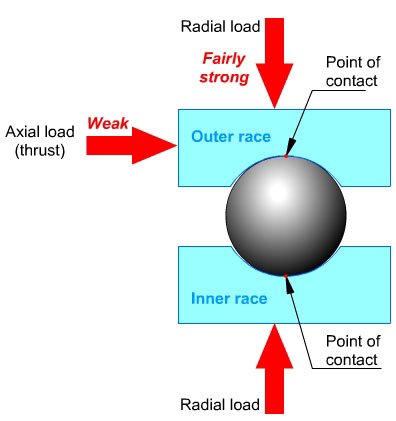
|
|
 |
| |
|
|
Cylindrical Roller Bearings
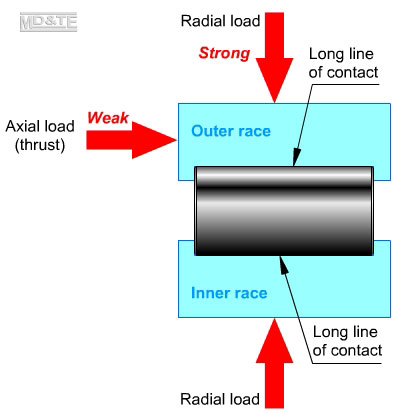
|
|
Cylindrical roller bearings have a similar design to ball bearings but instead of hardened steel balls, hardened steel cylinders are used as the rolling elements.
The steel cylinders have a narrow line of contact with the inner and outer races. This makes them almost as friction free as ball bearings but the long line of contact between the cylinder roller bearing and the inner and outer races enables these bearings to withstand very heavy radial loads.
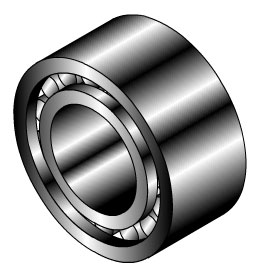
|
| |
|
|
Needle Roller Bearings
Needle roller bearings are similar to cylindrical roller bearings but the cylindrical rolling elements are much smaller in diameter, i.e. more like needles.
Because the rolling elements have a small diameter, a larger number of them are used than in a similar sized cylindrical roller bearing. This enables needle roller bearings to carry greater loads than cylindrical roller and ball bearings. |
|
Spherical Roller bearings
Spherical roller bearings consist of two rows of spherical rollers that match the curvature of the inner and outer races. Due to the curvature of the inner and outer race profiles, this bearing can take a small amount of misalignment between the bearing and the shaft. |
Bearings illustrations in this panel by kind permission of Silberwolf |
|
|
|
|
Deep groove roller bearing |
Cylindrical roller bearings |
|
Taper roller bearing |
|
Taper Roller bearings
Taper roller bearings consist of a number of truncated conical rolling elements held in a cage between the inner and outer races.
Taper roller bearings have a high load bearing capacity due to the line contact between each of the roller bearings and the inner and outer races. Taper roller bearings can support radial and axial loads. |
| |
|
|
Thrust bearings
Thrust bearings consist of either ball or cylindrical rolling elements held between two plates. Thrust bearings are designed to take compression loads. |
|
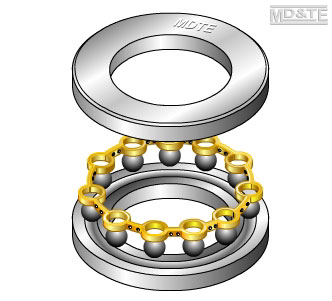
|
Bearing photos

Click on the screenshot above to view the bearing photos by Laszlo Lipot
|
|
|
|
|
